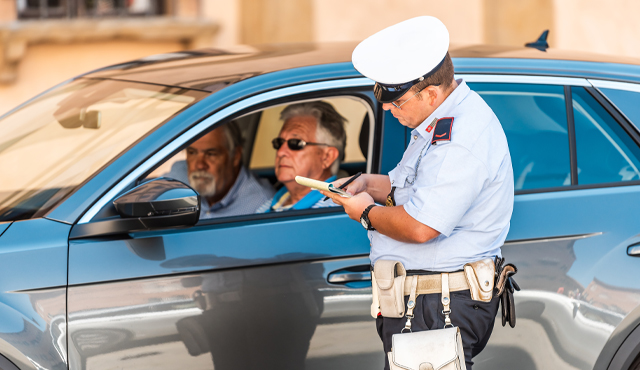Italy’s new Road Traffic Code, approved in late 2024, introduces substantial changes for drivers nationwide. Effective Dec. 14, 2024, the updated rules aim to enhance road safety, regulate emerging transportation modes like e-scooters, and implement stricter penalties for common violations. Here’s what drivers — both residents and visitors — should know about this reform.
Stricter Penalties for Dangerous Behavior — One of the most significant updates is the increased penalties for using mobile phones while driving. Drivers caught texting or calling without a hands-free system face fines ranging from €250 to €1,000. Additionally, license suspension for at least one week is now automatic if the offender has at least 10 infraction “points” on their license, while if he has less than 10 points, the suspension may be up to 15 days. Higher sanctions are provided if the driver is a repeat offender. The changes reflect a zero-tolerance approach to distracted driving, a leading cause of accidents on Italian roads.
New Rules for E-Scooters and Cyclists — E-scooters (electric standing scooters), increasingly popular in urban areas, are now subject to stricter regulations. Riders must have registration plates and insurance. Speed limits for scooters are set at 20 km/h on roads and 6 km/h in pedestrian zones. These measures aim to address safety concerns and ensure better accountability.
Cyclists, too, benefit from improved safety measures. Drivers overtaking bicycles must maintain a minimum distance of 1.5 meters, a rule designed to protect vulnerable road users.
Alcohol and Drugs — A significant tightening of regulations also applies to driving under the influence of alcohol, with penalties varying based on blood alcohol concentration (BAC) levels. For a BAC between 0.5 and 0.8 grams per liter — approximately equivalent to one to two glasses of wine depending on the individual — offenders face a fine ranging from €573 to €2,170 and a license suspension of three to six months. If the BAC is between 0.8 and 1.5 grams per liter — typically the result of two to four glasses of wine — the penalty increases to a fine of €800 to €3,200, jail time for up to six months, and a suspension of the license. For a BAC exceeding 1.5 grams per liter, often corresponding to four or more glasses of wine, fines range from €1,500 to €6,000, imprisonment for up to one year, and license suspension for one to two years. In all cases, 10 points are deducted from the driver’s license. The zero-tolerance alcohol limit remains in place for drivers operating vehicles requiring higher-class licenses.
Regarding driving under the influence of drugs, the reform has changed the old law by removing the requirement to prove that a driver was actually “altered” or impaired by the substance at the time of driving. Previously, it was necessary to show that the substance was affecting the driver’s ability to operate the vehicle. However, under the new law, any trace of drugs detected in a person’s system through a test is enough to impose penalties, even if the person is not visibly impaired. A key concern is the example of cannabis, whose traces can remain in a person’s system for days, while the effects of the drug last only a few hours. This means someone could test positive for cannabis long after the drug’s effects have worn off, even though they may be fully capable of driving. This approach might be viewed as too harsh, and some may challenge it as unconstitutional.
Speeding Violations — The reform introduces higher fines for speeding violations, which could add further concerns to the debate over the proportionality of penalties. For those exceeding speed limits by more than 10 km/h and up to 40 km/h, fines now range from 173 to 694 euros. If the violation occurs within a residential area and at least twice within a year, the penalty increases to between 220 and 880 euros, and the driver’s license could be suspended for 15 to 30 days. So pay attention!
Low Emission Zones and Environmental Measures — The new code also formalizes the creation of new and more Low Emission Zones in urban centers. This initiative prioritizes environmental sustainability by restricting access for high-emission vehicles. While these zones primarily affect residents, tourists and other visitors should check whether their vehicles meet the required standards.
A Friendly Reminder to our Italian-American Friends — So, forget what Nonno used to say about wine being “good for the blood”: The new rules are here, and they mean business. Whether you’re zipping through Rome’s cobbled streets or cruising along the scenic Amalfi Coast, make sure to stay sharp and keep an eye on those speed limits and alcohol levels. With stricter penalties for offenses, it’s more important than ever to respect the new regulations. After all, no one wants their vacation memories tainted by a fine or worse, a license suspension while in Italy.
Send your questions regarding Italian law to cbortolani@aliantlaw.com and I’ll be glad to answer them.
The content provided in this Q&A column is intended solely for general informational purposes and does not constitute legal advice. The information presented here is not tailored to any specific situation or transaction and should not be relied upon as a substitute for professional legal counsel. Legal issues can vary widely based on individual circumstances and jurisdictional nuances. Therefore, it is crucial to consult with a qualified legal professional regarding your specific case or concerns. Please be aware that no attorney-client relationship is established by accessing or interacting with the information provided in this column. The column’s author and publisher disclaim any liability for actions taken based on the information contained herein.
 Fra Noi Embrace Your Inner Italian
Fra Noi Embrace Your Inner Italian






